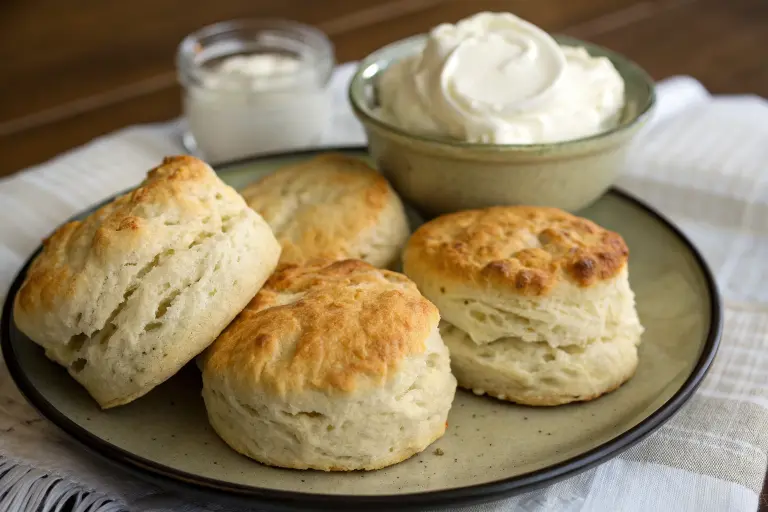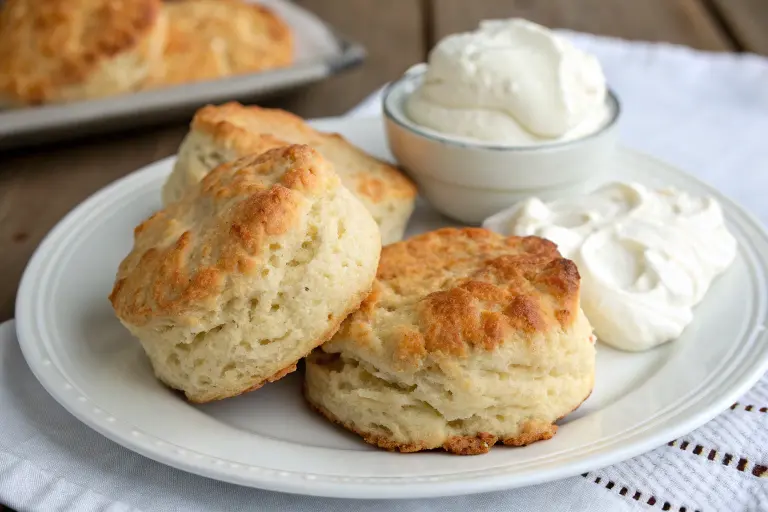Biscuits are a beloved comfort food, especially when they’re flaky, soft, and buttery. If you’ve ever found yourself asking, “Why are my Bisquick biscuits so dry?” you’re not alone. Dry biscuits are a common baking issue, but understanding why they turn out this way can help you adjust and get the desired results.
In this article, you will discover the most common reasons your Bisquick biscuits might end up dry and how to fix them. Keep reading to discover some practical solutions for baking light, tender biscuits every time.
Why Biscuit Consistency Matters
A good biscuit should have a crisp golden-brown exterior, but inside it should be moist, tender, and light. Bisquick biscuits, in particular, are known for their ease and speed of preparation, making them a favorite for busy home bakers. However, it can be disheartening when your batch turns out dry and dense. Achieving the perfect biscuit involves understanding the key factors that affect its texture. Let’s explore why your Bisquick biscuits might not be coming out as expected.
Understanding Bisquick Biscuit Ingredients
To troubleshoot dry biscuits, it helps first to understand the basic ingredients in the Bisquick mix. Bisquick combines flour, baking powder, and salt, providing the foundation for quick breads like biscuits. The liquid typically used is milk, but buttermilk can also be used for a slightly tangy flavor. Butter or shortening is usually incorporated for a rich, flaky texture. These ingredients are meant to work together to create a balanced dough that bakes into tender, fluffy biscuits.

Why Are My Bisquick Biscuits So Dry? Key Factors
If you find yourself asking, “Why are my Bisquick biscuits so dry?”, it’s likely due to a few common missteps during the preparation or baking process. Biscuits can quickly turn dry, tough, and crumbly, but understanding these key factors and how to address them will help you achieve tender, moist biscuits every time. Let’s dive into the primary reasons behind dry Bisquick biscuits and how to troubleshoot them effectively.
Too Much Bisquick Mix
One of the leading causes of dry Bisquick biscuits is using too much of the Bisquick mix itself. Although it may seem like adding extra flour or mix can help with the texture, it often results in biscuits that are too dense and dry. Using too much Bisquick creates a dough that lacks moisture and structure, which leaves the biscuits heavy and crumbly rather than soft and tender.
Solution:
Always measure the Bisquick mix carefully to prevent dry Bisquick biscuits due to excess mix. Instead of scooping the mix directly from the container, spoon it into your measuring cup and level it off with a knife. This method ensures that you’re using the correct amount of Bisquick and prevents packing, which can make the biscuits drier.
Additionally, if you feel your dough is too thick or stiff, don’t hesitate to add a little more liquid to achieve the right consistency. Biscuits made from Bisquick should have a soft, slightly sticky texture, not one that is dry or crumbly.
Inadequate Liquid Ratio
Another reason you might be asking, “Why are my Bisquick biscuits so dry?” is because you haven’t added enough liquid. The right liquid-to-dry ingredients ratio is crucial for achieving the perfect biscuit. Without enough moisture, the dough won’t rise properly, and your biscuits will be dense and dry. Bisquick biscuits require just enough liquid to form a dough that can be dropped or patted into shape. Too little liquid in the dough causes the biscuits to end up dry and lacking in structure.
Solution:
To avoid dry Bisquick biscuits, be sure to follow the recipe’s liquid measurements precisely. If the dough seems dry and crumbly, it’s a sign that you need more liquid. Add milk, one tablespoon at a time, until the dough reaches a soft, slightly sticky texture. Bisquick biscuits should not be overly wet, but they should hold together well and be moist enough to rise properly in the oven.
Using a different liquid, such as buttermilk, can also help increase the moisture content and provide extra tenderness. Just be mindful that using too little liquid, regardless of type, can lead to dry biscuits.
Overworking the Dough
Another common mistake when making Bisquick biscuits is overworking the dough. Overmixing or over-kneading the dough activates the gluten in the flour, leading to tough, dense, and dry biscuits. Biscuits need minimal handling to ensure they remain light and flaky. The more you mix and knead, the more the gluten develops, which negatively impacts the texture and causes dryness.
Solution:
To avoid overworking the dough, gently mix the ingredients until they just come together. If you’re rolling out the dough, be careful not to press down too hard. Instead, lightly pat the dough into shape with your hands. The goal is to handle the dough as little as possible. When you shape the dough, use a light touch to maintain a tender, flaky consistency.
If you need to roll out the dough, do so just enough to form biscuit rounds. Too much rolling and handling will lead to a tougher texture and drier biscuits.
Baking Temperature Issues
The temperature of your oven plays a critical role in how your Bisquick biscuits turn out. If the oven is too hot or cold, it can affect how the biscuits rise, brown, and bake. An oven that’s too hot might cause the exterior of your biscuits to brown too quickly while leaving the interior undercooked and dry. On the other hand, a temperature that’s too low can result in biscuits that don’t rise sufficiently, leaving them dense and dry throughout.
Solution:
To prevent dry biscuits, make sure your oven is preheated to the correct temperature, typically 450°F (230°C) for Bisquick biscuits. An oven thermometer can help ensure that your oven is accurate, as some ovens can run hot or cold, which affects baking results. A high, consistent temperature allows the biscuits to bake quickly, creating a light and fluffy texture. This rapid baking prevents the dough from drying out and ensures the biscuits stay moist inside.
Furthermore, avoid opening the oven door frequently while the biscuits are baking, which can cause temperature fluctuations that might affect the baking process. When the biscuits are done, they should be golden brown on the outside and soft and tender on the inside.
Summary of Key Factors for Dry Bisquick Biscuits
- Too much Bisquick mix: Measure the mix properly to avoid making the dough too stiff and dry.
- Inadequate liquid: Ensure the dough is moist enough by adding liquid gradually until it reaches a soft, slightly sticky texture.
- Overworking the dough: Mix and handle the dough minimally to avoid activating gluten, which leads to tough, dry biscuits.
- Baking temperature: Preheat the oven to the correct temperature, and avoid fluctuations during baking to ensure the biscuits cook evenly and stay moist.
By addressing these factors, you can answer the question “Why are my Bisquick biscuits so dry?” and enjoy biscuits that are consistently soft, tender, and delicious. Proper measurement, careful handling, and the right baking environment are key to perfect results.
Tips to Avoid Dry Biscuits
Now that you have a clear understanding of the common reasons why your Bisquick biscuits might turn out dry, it’s time to focus on practical tips to help you consistently bake soft, tender, and moist biscuits. These simple yet effective techniques will make a significant difference in your biscuit-making process, ensuring you avoid dry, dense biscuits in the future.
1. Use Cold Ingredients
One of the key secrets to achieving flaky, tender Bisquick biscuits is using cold ingredients. Cold butter, shortening, or any fat used in the dough helps create a flaky texture by preventing the fat from fully incorporating into the dough. When cold fat is added to the dough, it creates small pockets of air, which expand in the oven, giving your biscuits that light, airy structure you’re aiming for.
Why It Works:
- Cold fat helps maintain the structure of the dough, creating layers that rise and separate during baking.
- If the butter or shortening melts into the dough before baking, you’ll lose those crucial flaky layers, resulting in biscuits that are flat and dry.
Tip:
- Cut your butter into small cubes before adding it to the Bisquick mix, and ensure the butter stays cold throughout the preparation process. If you’re short on time, place the fat in the freezer for a few minutes before using it.
2. Don’t Overmix the Dough
While it might be tempting to thoroughly mix the dough to ensure all the ingredients are fully incorporated, overmixing is one of the biggest culprits for dry biscuits. When you overmix the dough, you activate the gluten in the flour, which can lead to tough, dense biscuits instead of light and fluffy ones. For the best results, you should aim for the just combined method, which ensures that the ingredients come together without overworking the dough.
Why It Works:
- Gluten provides structure, but when overworked, it can result in chewy biscuits rather than tender ones.
- Biscuits need a gentle hand to preserve the light, flaky texture. Overmixing develops too much gluten, making them tough and dry.
Tip:
- Mix the ingredients until the dough just comes together. If using a stand mixer or spoon, stop once the dough is fully combined but still slightly rough in texture. Don’t knead it more than necessary.
3. Add Extra Liquid If Needed
Another common cause of dry biscuits is not adding enough liquid to the dough. Bisquick biscuits are meant to be moist but not sticky. Sometimes, depending on environmental factors, the Bisquick mix may absorb different amounts of liquid, so the dough could turn out drier than expected. If you notice that the dough is too crumbly or doesn’t come together easily, adding a bit more liquid can help restore the right texture.
Why It Works:
- Additional liquid helps bind the dry ingredients together, making the dough moist enough to rise properly and become tender during baking.
- Bisquick mixes can absorb varying amounts of liquid, so a little extra moisture can ensure the biscuits turn out soft and fluffy.
Tip:
- If your dough looks too dry, add liquid (such as milk or buttermilk) gradually, one tablespoon at a time, until the dough reaches a slightly sticky, soft consistency. Be careful not to add too much, as this can make the dough too wet, resulting in biscuits that won’t hold their shape.
4. Use Fresh Bisquick
Using fresh Bisquick is another important factor in avoiding dry biscuits. Bisquick is a pre-made mix that contains leavening agents like baking powder, which can lose potency over time. If your Bisquick mix is old or expired, it may not rise as effectively, leading to flat, dense, and dry biscuits. Always check the expiration date on the Bisquick box before you use it.
Why It Works:
- Fresh Bisquick ensures that the leavening agents are still active and can create the necessary lift during baking. When the leavening agents are no longer effective, your biscuits won’t rise as expected and will turn out dense and dry.
- Using expired Bisquick will negatively impact your biscuits’ texture and moisture content.
Tip:
- Always check the expiration date on the box of Bisquick, and if it’s close to expiration, consider purchasing a new box. You can also store Bisquick in a cool, dry place to preserve its freshness for longer.
5. Bake Immediately
Once you’ve mixed your dough, baking your Bisquick biscuits immediately is important. Like other biscuit doughs, the Bisquick mix relies on the activation of baking powder to rise during baking. If you let the dough sit for too long before baking, the leavening agents will lose their effectiveness, and the biscuits may turn out dry and dense.
Why It Works:
- Biscuits rise best when the leavening agents are active in a hot oven. Allowing the dough to sit too long before baking can cause the leavening agents to lose their power, resulting in flat, dry biscuits.
- Immediate baking ensures that the biscuits rise quickly and evenly, creating a tender, flaky texture.
Tip:
- Preheat your oven and prepare your baking sheet before mixing the dough. As soon as the dough is prepared, shape the biscuits and place them on the sheet, then put them directly into the oven for the best rise and texture.

Common Mistakes to Avoid While Making Biscuits
Even with the best intentions, a few common mistakes could still lead to dry biscuits. Here are some to avoid:
- Not Preheating the Oven: If your oven isn’t preheated, the biscuits won’t bake properly, affecting their texture.
- Overcrowding the Baking Sheet: Biscuits need space to spread out while baking. If they’re too close together, they may not rise as well.
- Ignoring the Texture of the Dough: Pay attention to the dough consistency. If it’s too dry, it will lead to dry biscuits after baking.
- Using Room Temperature Fat: Warm or melted butter won’t create the same flakiness. Cold butter or shortening is the best choice.
FAQs:
❓ Why are my Bisquick biscuits dry and crumbly?
Dry and crumbly Bisquick biscuits can result from using too much Bisquick mix, not enough liquid, or overworking the dough. Make sure to measure the Bisquick carefully, add enough liquid, and mix gently.
❓ How to keep Bisquick biscuits from being dry?
To keep Bisquick biscuits from being dry, use cold ingredients, avoid overmixing the dough, and ensure you’re using enough liquid. Bake immediately after preparing the dough to preserve moisture.
❓ Why are my homemade biscuits so dry?
Homemade biscuits can turn out dry due to insufficient liquid, overmixing, or baking at the wrong temperature. Use fresh ingredients, add extra liquid if needed, and ensure your oven is preheated.
❓ What to do if biscuit dough is too dry?
If your biscuit dough is too dry, gradually add liquid (like milk or buttermilk) a tablespoon at a time until the dough reaches a soft, slightly sticky consistency. Avoid overworking it after adding the liquid
Conclusion: Perfect Biscuits Every Time
Baking perfect Bisquick biscuits can be tricky, but you can make the necessary adjustments to improve your results by understanding why they might turn out dry. Whether it’s measuring the Bisquick mix properly, adding enough liquid, or not overworking the dough, each step plays a role in creating the perfect biscuit texture. With a bit of practice and attention to detail, you can make moist, tender, and delicious biscuits every time.
By following these tips, you can easily avoid the common mistake of dry Bisquick biscuits. Using cold ingredients, avoiding overmixing, adding extra liquid when necessary, ensuring your Bisquick is fresh, and baking the dough immediately are all critical steps in ensuring your biscuits come out perfectly moist and tender. Remember, biscuit-making doesn’t have to be complicated, and with just a little attention to detail, you’ll be able to enjoy soft, flaky biscuits with every batch. Happy baking!
For more delightful recipes, check out 3-Ingredient No-Bake Cheesecake or make some Vegan Banana Pancakes. These treats are as easy to make and as delicious as your perfect Bisquick biscuits. Whether you’re craving something sweet or savory, we’ve covered you with simple recipes you can rely on.
Don’t forget to discover our full collection of recipes and stay updated with all the latest from Chaynez Recipes. Connect with us for even more tips, tricks, and recipes to make your kitchen time enjoyable and rewarding.






